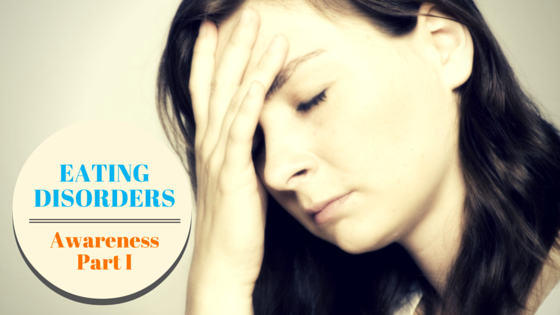
Eating disorders are very common in many parts of the world. In the United States, it is estimated that more than 20 million women and 10 million men have suffered from an eating disorder at some point in their life (Nationaleatingdisorders.org, 2016). In the United Kingdom, approximately 725,000 people are currently battling an eating disorder (BEAT – Beating Eating Disorders, 2016).
The danger of eating disorders is often underestimated. Eating disorders have the highest mortality rate of any mental illness and can severely impact a person’s physical and mental health (Anad.org, 2016).
It is important to be aware of the symptoms of these illnesses, because they can affect people of any age or gender. This article will take a look at the most common types of eating disorders and the reasons why eating disorder awareness is crucial.
What are Eating Disorders?
Eating disorders are complex diseases that can require both physical and mental therapy to overcome. They are considered mental disorders by physicians. However, there is a growing body of evidence that suggests a person’s genetic or biological make up can play a role in the development of an eating disorder. The exact cause of eating disorders is not known.
Eating disorders are more common in women than they are in men, and mostly affect younger people. In the United Kingdom, 89% of people affected by eating disorders are women (Anad.org, 2016).
Many people are hesitant to talk to a physician about an eating disorder, so cases often go unreported. Unfortunately, ignoring the danger of an eating disorder can allow it to develop into a very serious and life-threatening condition.
Types of Eating Disorders
The most common forms of eating disorders include:
1. Anorexia Nervosa
People with this condition have a distorted view of their body size and are fearful of gaining weight. As of a result of this, they avoid eating and become very underweight. Many people with anorexia will also over-exercise in an attempt to reduce their weight and become very obsessive about the number of calories they eat each day. Sometimes anorexics will binge eat for a short period then purge themselves by trying to throw up and/or using laxatives.
Symptoms of anorexia can include obsessive dieting and calorie counting, unusual food rituals, purging using laxatives or other drugs, brittle hair, yellow skin, body weight 15% or more below normal weight, depression, chronic fatigue and halitosis.
2. Bulimia Nervosa
This eating disorders is very similar to anorexia. People with bulimia will eat to excess, then attempt to compensate in very extreme ways — for example, throwing up or attempting to exercise for long periods.
This repeated cycle of binge eating then taking extreme measures to compensate can be very taxing, physically and emotionally. People who have had bulimia for a long time begin to develop compulsive behaviours that are difficult to stop. Unlike anorexia, people with bulimia often maintain an average weight and will not become thin and underweight.
Symptoms of bulimia include dental erosion caused by from frequent vomiting, electrolyte imbalance, constipation, peptic ulcers, inflammation of the oesophagus, dehydration, gastroesophageal reflux and infertility.
3. Binge Eating Disorder (BED)
Similar to bulimia, this eating disorder involves binge eating — however, no purging is involved afterwards. It is estimated that BED affects 0.8% of males and 1.6% of females in the United States (American Psychiatry Association, 2013).
The signs of this disorder include eating a large amount of food in a very short period, exhibiting a lack of control while eating, eating very rapidly and eating despite not being hungry. A binge eating episode is usually followed up by feelings of guilt, depression and embarrassment.
Why Eating Disorder Awareness is so Important
Eating disorder awareness is crucial for a number of reasons, including:
1. Understanding the symptoms of eating disorders helps people avoid them
By being aware of the behaviours and patterns that occur in the early stages of an eating disorder, it is much easier to avoid them. You can focus on healthy eating and refuse to enter into any unhealthy eating habits.
2. People sometimes aren’t aware they have a disorder
Eating disorders are very insidious and can creep up on people without them being aware they have a problem. When more people are aware of the symptoms of eating disorders, that can identify the illness taking hold of their friends or relatives and inform them. That helps people get diagnosed early and receive treatment early.
3. The earlier the disorder is diagnosed, the easier treatment is
Eating disorder awareness help people realise they have a problem and they can seek treatment early. The earlier a person seeks treatment, the greater the likelihood of a quick recovery.
In part II of this series on eating disorder awareness, we will take look at the current treatments for eating disorders and what role stem cells may play in treating these illnesses in the future.
Sources
American Psychiatry Association (2013). Diagnostic and Statistical Manual of Mental Disorders (5th ed.). Arlington: American Psychiatric Publishing. pp. 329–354. ISBN 0890425558.
Nationaleatingdisorders.org,. (2016). Get The Facts On Eating Disorders | National Eating Disorders Association. Retrieved 18 February 2016, from https://www.nationaleatingdisorders.org/get-facts-eating-disorders
Anad.org,. (2016). Eating Disorders Statistics – National Association of Anorexia Nervosa and Associated Disorders. Retrieved 18 February 2016, from http://www.anad.org/get-information/about-eating-disorders/eating-disorders-statistics/
BEAT – Beating Eating Disorders,. (2016). Eating Disorder Statistics. Retrieved 18 February 2016, from https://www.b-eat.co.uk/about-beat/media-centre/information-and-statistics-about-eating-disorders

